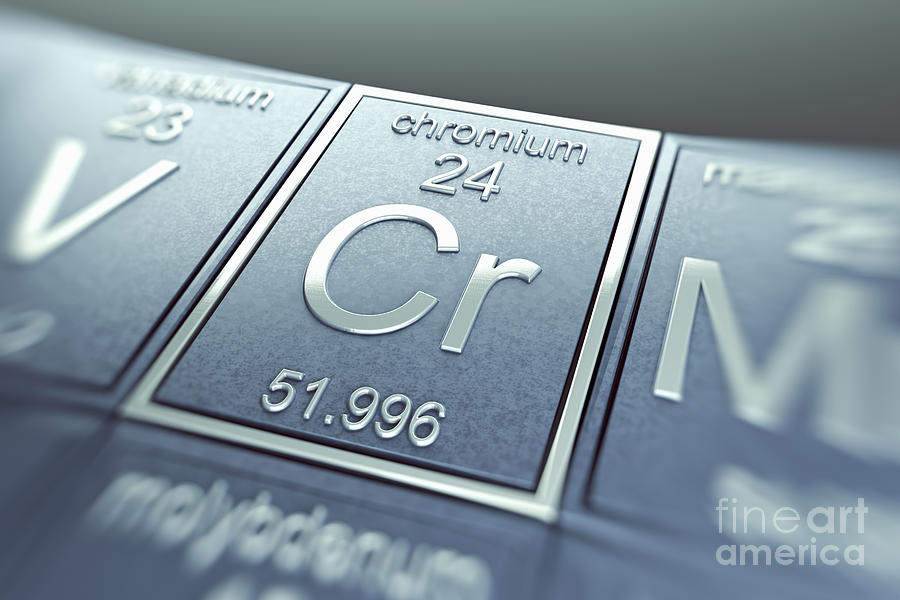

It turns into green oxide (Cr 2O 3) when heated.Human foods that are rich in chromium include wheat gram, kidney, and brewer’s yeast.The element is graphically represented to indicate its mirror-like shine and toxic nature.
#Chromium atomic number skin
Accidental or occupational exposure to chromium compounds (especially hexavalent chromium compounds) can cause irritation and obstruction of the airways, nasal, lung, or sinus cancer, skin allergies, renal tubular damage, liver abnormalities, and cardiovascular collapse. Īlthough chromium is found in trace amounts in the human body and it helps us in utilizing glucose, it can be poisonous when inhaled or ingested in excess (more than 1 mg a day). Chromium Basic Facts Chromium Atomic Number: 24 Chromium Symbol: Cr Chromium Atomic Weight: 51. Its compounds are used for dyeing fabrics in the textile industries and anodizing aluminum by the aircraft industries. Chromium is element atomic number 24 with element symbol Cr.Furnaces and kilns in industries are made with chromite ore since it can withstand high temperatures.

The red color of rubies comes from chromium while the emerald green color in glasses is also obtained by treating it with chromium.
Its compounds are valued as catalysts and pigments. Animal skin is treated with chromium sulfate to turn it into hot water-resistant leather. It is used for tanning 90 percent of all the leather in the world. Chromium-plated bathroom fittings and automobile parts are commonly used for their corrosion resistance properties. Electroplating a layer of chromium provides a polished mirror-like finish to steel. Chromium is used for producing many metal alloys, including steel, thereby hardening and protecting them from rust. State of matter at room temperature (solid/liquid/gas)Ĭhromium Electron Configuration (Bohr Model) What is Chromium Used for He also found that the green color of emeralds was due to the presence of chromium. Since the new element could produce a wide range of colors in solution, he called it chromium after the Greek ‘chroma’. In 1798, he dissolved the mineral in hydrochloric acid to create a mixture, precipitated lead to filter it off, and then successfully isolating chromium from the remaining filtrate. Louis Nicolas Vauquelin, being captivated by the red mineral (Siberian red lead) found in a gold mine in Siberia in 1766, started experimenting with it to confirm that it was a mineral containing lead. Who discovered it: The French chemist and pharmacist Louis Nicolas Vauquelin is known for the discovery of chromium. It may be found in kimberlite pipe, where the reducing atmosphere favors the formation of diamond in addition to elemental chromium.Origin of its Name: The element is named after the Greek word ‘chroma’, which means “color”. Although it is rare, native chromium also exists. Most chromium is obtained by mining the mineral chromite. It is present at a concentration of approximately 100 parts per million. Chromium is the 21st or 22nd most abundant element in the Earth's crust. The coated is metal is usually called chrome. Chromium in air is passivated by oxygen, forming a protective layer that is essentially a spinel that is a few atoms thick. Chromium is used to prepare pigments (including yellow, red, and green), to color glass green, to color rubies red and emeralds green, in some tanning processes, as a decorative and protective metal coating, and as a catalyst. The most stable isotope is chromium-50, which has a half-life of over 1.8×10 17 years. Nineteen radioisotopes have been characterized. 
Chromium-52 is the most abundant isotope, accounting for 83.789% of its natural abundance.
Chromium occurs naturally as a mix of three stable isotopes: Cr-52, Cr-53, and Cr-54. The +1, +4, and +5 oxidation states also occur, although they are less common. Hexavalent chromium and its compounds are extremely toxic and also carcinogenic. 
Trace amounts of trivalent chromium are needed for lipid and sugar metabolism.Chromium becomes paramagnetic above 38 degrees Celsius. The element's magnetic properties are among its most notable characteristics. Chromium is the only element that shows antiferromagnetic ordering in its solid state at and below room temperature.Stainless steel is hard and resists corrosion due to the addition of chromium.Like many transition metals, it has a high melting point (1,907 degrees C, 3,465 F) and a high boiling point (2,671 degrees C, 4,840 F). Chromium is a hard, lustrous, steel-gray metal. Chromium may be highly polished.It is the first element in group 6 on the periodic table, with an atomic weight of 51.996 and a density of 7.19 grams per cubic centimeter.








 0 kommentar(er)
0 kommentar(er)
